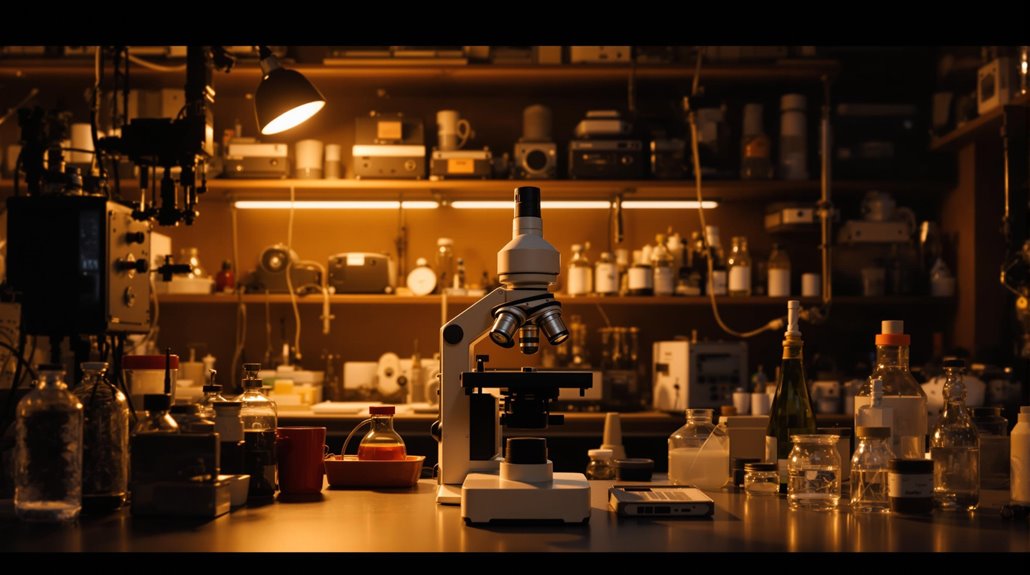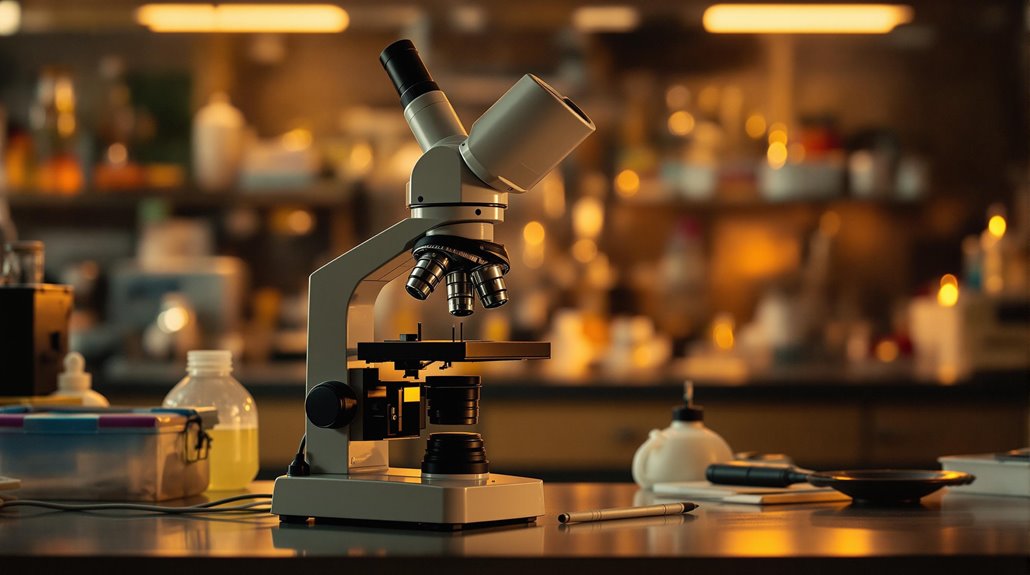Ann Tsukamoto’s Stem Cell Breakthrough: Lab Trials That Shocked Skeptics
You've probably heard of stem cell therapy, but you might not know about the scientist who made one of its biggest breakthroughs possible. In 1991, Ann Tsukamoto achieved what many thought impossible: she isolated human blood-forming stem cells. Her discovery faced intense skepticism from the scientific community, yet her meticulous lab trials proved the critics wrong. What happened next would transform modern medicine and challenge everything we thought we knew about cellular therapy.
The Discovery That Changed Modern Medicine

While numerous medical breakthroughs have shaped healthcare, the 1991 isolation of human stem cells stands as a defining moment in modern medicine.
Despite initial ethical considerations and skeptical public perception, the co-patented process to isolate human hematopoietic stem cells revolutionized how we approach disease treatment.
The groundbreaking discovery at SyStemix didn't just identify blood-forming stem cells – it created a homogenous composition that would save hundreds of thousands of lives.
You'll find this breakthrough's impact particularly evident in cancer treatment, where purified stem cells have successfully regenerated patients' blood-forming systems.
The transgenic breast cancer model developed during her postdoctoral work laid crucial groundwork for understanding stem cell behavior in disease.
Recent studies exploring stress exposure methods to reprogram mature cells have shown both promise and controversy in advancing stem cell research.
The method has proven invaluable for bone marrow transplants and immune system replacement, offering hope to those with previously untreatable conditions.
What started as a laboratory innovation has transformed into a cornerstone of modern medical treatment.
Revolutionizing Cancer Treatment Through Stem Cells
As researchers uncover the complex relationship between stem cells and cancer, groundbreaking treatments continue to emerge.
These cancer innovations are transforming how you'll receive treatment in the future, with stem cell therapies leading the charge against this devastating disease. Personalized medicine approaches will allow doctors to tailor treatments to each patient's specific cancer type. Current recovery periods after chemotherapy could be reduced from three weeks to one to two weeks with new targeted therapies.
Here's what's revolutionizing cancer treatment:
- Cancer stem cell targeting: Scientists at Stanford are developing drugs that block harmful proteins in cancer cells, preventing them from regenerating tumors.
- Differentiation therapy: A gentler alternative to chemotherapy that reprograms cancer cells to become normal cells, stopping tumor growth.
- Enhanced transplant effectiveness: The discovery of syndecan-2 protein makes blood stem cell transplants more efficient, while the graft-versus-tumor effect helps donor cells fight remaining cancer cells.
These breakthroughs are reshaping cancer treatment strategies, offering hope for more effective and less toxic options.
From Laboratory Success to Clinical Breakthroughs
Since the groundbreaking isolation of human hematopoietic stem cells in 1991, laboratory discoveries have rapidly transformed into life-saving clinical applications.
Her early research at UCLA laid the foundation for these groundbreaking discoveries.
You'll find that these laboratory techniques proved essential when researchers demonstrated that purified hHSC could be cancer-free, even when isolated from contaminated blood samples.
The shift from lab to clinic has been remarkable. Clinical trials showed successful regeneration of patients' blood-forming systems post-chemotherapy, while research expanded into neural and liver stem cells.
As SyStemix's executive VP, Tsukamoto continued advancing stem cell innovations through strategic research partnerships. You can see the impact in the hundreds of thousands of lives saved through these innovations. The development of HuCNS-SC® marked another milestone, proving particularly promising for treating neurological disorders.
What started in a laboratory has evolved into patented methods now critical for bone marrow transplants in blood cancer patients.
Overcoming Scientific Doubt and Criticism
Despite widespread skepticism in the scientific community, Tsukamoto's breakthrough in stem cell isolation emerged victorious through rigorous validation and persistence.
When faced with scientific skepticism and concerns about ethical implications, she tackled doubts head-on with meticulous documentation and collaborative research. Like current clinical trials for therapies, there were extensive testing phases required to validate the findings.
Three key factors contributed to overcoming initial resistance:
- Development of detailed, reproducible protocols that other labs could follow
- Implementation of stringent quality control measures to guarantee consistent results
- Presentation of compelling evidence at scientific conferences backed by peer-reviewed publications
You'll find it remarkable how Tsukamoto's systematic approach gradually transformed skeptics into supporters.
By working alongside ethicists and demonstrating potential medical applications, she addressed both scientific and moral concerns.
Her dedication to transparency and methodological refinement ultimately led to successful replication by other laboratories, cementing her breakthrough's legitimacy.
Expanding the Frontiers of Stem Cell Applications

While Tsukamoto's initial breakthrough laid the groundwork, today's stem cell applications have expanded far beyond early expectations. You'll find stem cell therapies now treating everything from blood disorders to multiple sclerosis, with promising developments in Alzheimer's and liver disease treatment.
The field of regenerative medicine has particularly flourished, offering hope for patients with heart disease, Parkinson's, and spinal cord injuries. Scientists aren't just treating diseases – they're combining gene editing with stem cells to tackle hereditary disorders and creating personalized treatments using patient-derived cells. The development of induced pluripotent stem cells has revolutionized the field by reducing ethical concerns around embryonic stem cell use. Autologous stem cells have enabled successful artificial trachea production for patients.
Clinical trials worldwide are pushing boundaries even further, testing mesenchymal stem cells for kidney disease and exploring innovative cancer treatments. Global research initiatives, from India's cord blood applications to Mayo Clinic's stem cell banking, are accelerating these advances at an unprecedented pace.
The Legacy and Future of Tsukamoto's Research
As Tsukamoto's groundbreaking discoveries continue to shape modern medicine, her legacy extends far beyond the initial isolation of human stem cells.
 induced pluripotent cells has helped address many ethical concerns while maintaining research progress.
induced pluripotent cells has helped address many ethical concerns while maintaining research progress.
Her vision for the future of regenerative medicine includes:
- Revolutionizing bone marrow transplants through advanced stem cell techniques
- Creating artificial organs using combined stem cell and gene editing technologies
- Developing novel treatments for liver diseases through specialized cell regeneration
You're witnessing the evolution of her work as it progresses from lab discoveries to clinical applications.
While at StemCells Inc., she's pushed boundaries in neural stem cell research, setting the stage for future breakthroughs in treating central nervous system disorders and expanding possibilities in cardiac tissue engineering. Her pioneering work with lysosomal storage disease has demonstrated remarkable success in preclinical studies, showing enzyme restoration in affected cells.










